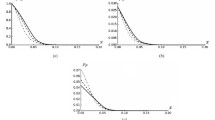Abstract
In the framework of a three-fluid approach, a new model of suspension filtration in a porous medium is constructed with account for the formation of a dense packing of trapped particles with finite permeability and porosity. The following three continua are considered: the carrier fluid, the suspended particles, and the deposited particles. For a one-dimensional transient flow of suspension, a system of equations for the concentrations of the suspended and deposited particles, the suspension velocity, and the pressure is constructed. Two cases of the flow in a porous medium are considered: plane and radial. Numerical solution is found using a finite-difference method. Numerical calculations are shown to be in agreement with an analytical solution for the simplest case of filtration with a constant velocity and constant porosity and permeability. A comparison is performed with the classic filtration models for five sets of experimental data on the contamination of a porous sample. It is shown that near the inlet boundary, where an intense deposition of particles takes place, the new model describes the concentration profile of the deposited particles more accurately than the classical model.
Similar content being viewed by others
References
R.I. Nigmatulin, Dynamics of Multiphase Flow. V.1,2 (Hemisphere, New York, 1989).
C. Gruesbeck and R.E. Collins, “Entrainment and Deposition of Fine Particles in Porous Media,” SPE Journal (8430), 847–856 (1982).
L. Bailey, E.S. Boek, S.D.M. Jaques, et al., “Particulate Invasion FromDrilling Fluids,” SPE Journal 5(4), 412–419 (2000).
H. Fallah and S. Sheydai, “Drilling Operation and Formation Damage,” Open Journal of Fluid Dynamics 3, 38–43 (2013).
E.S. Boek, C. Hall, and P.M.J. Tardy, “Deep Bed Filtration Modelling of Formation Damage due to Particulate Invasion from Drilling Fluids,” Transport in Porous Media 91 (2), 479–508 (2012).
Y.M. Shekhtman, Filtration of Low-Concentration Suspensions [in Russian] (Izd. AS USSR, Moscow, 1961).
A. Suri and M. Sharma, “Strategies for Sizing Particles in Drilling and Completion Fluids,” SPE Journal 1(1), 13–23 (2004).
R.G. Guedes, F. Al-Abduwani, P. Bedrikovetsky, and P.K. Currie, “Deep-Bed Filtration Under Multiple Particle- Capture Mechanisms,” SPE Journal 14 (3), 477–487 (2009).
A. Santos and P. Bedrikovetsky, “A StochasticModel for Particulate Suspension Flow in PorousMedia,” Transport in Porous Media 62, 23–53 (2006).
L.I. Sedov, A Course in Continuum Mechanics. V. 1 (Wolters-Noordhoff, Groningen, 1971).
N.N. Mikhailov, Variation ofPhysicalProperties ofRocks inNear-WellboreZones [in Russian] (Nedra, Moscow, 1987).
K.J. Scott, “Hindered Settling of a Suspension of Spheres: Critical Evaluation of Equations Relating Settling Rate to Mean Particle Diameter and Suspension Concentration,” in: Council for Scientific and Industrial Research. 1984.
M.A. Van Der Hoef, R. Beetstra, and J.A.M, Kuipers, “Lattice-Boltzmann Simulations of Low-Reynolds-Number Flow past Mono- and Bidisperse Arrays of Spheres: Results for the Permeability and Drag Force,” Journal of Fluid Mechanics 528, 233–254 (2005).
J.P. Herzig, D.M. Leclerc, and P. Le Goff, “Flow of Suspensions through Porous Media,” Industrial and Engineering Chemistry 62 (5), 9–34 (1970).
P.M. Heertjes and C.F. Lerk, “The Functioning of Deep Bed Filters,” Trans. Inst. Chem. 45, 124–145 (1967).
A.G. Kulikovskii, N.V. Pogorelov, and A.Y. Semenov, Mathematical Problems of Numerical Solution of Hyperbolic Systems of Equations [in Russian] (Fizmatlit, Moscow, 2001).
F. Civan, Reservoir Formation Damage (Gulf Professional Publishing, Elsevier Inc., 2007).
D.N. Mikhailov, N.I. Ryzhikov, and V.V. Shako, “Complex Experimental Approach to the Determination of the Parameters of a Calmatation Zone in Producing Reservoirs,” Vestnik TsKR Rosnedra (1), 7–11 (2014).
N.S. Bakhvalov, N.P. Zhidkov, and G.M. Kobel’kov, Numerical Methods [in Russian] (Binom, Moscow, 2008).
A.A. Samarskii, The Theory of Difference Schemes (Marcel Dekker Inc., New York–Basel, 2001).
J.T. Dewan and M.E. Chenevert, “A model for Filtration ofWater-Base Mud during Drilling,” Petrophysics 42(3). P. 237–250 (2001).
E.V. Chizhonkov, Lectures on the Course of Numerical Methods [in Russian] (Moscow University, Moscow, 2006).
K.S. Basniev, I.N. Kochina, and V.M. Maksimov, Subterranean Hydraulics [in Russian] (Nedra, Moscow, 1993).
Author information
Authors and Affiliations
Corresponding author
Additional information
Original Russian Text © S.A. Boronin, A.A. Osiptsov, K.I.Tolmacheva, 2015, published in Izvestiya Rossiiskoi Akademii Nauk, Mekhanika Zhidkosti i Gaza, 2015, Vol. 50, No. 6, pp. 50–62.
Rights and permissions
About this article
Cite this article
Boronin, S.A., Osiptsov, A.A. & Tolmacheva, K.I. Multi-fluid model of suspension filtration in a porous medium. Fluid Dyn 50, 759–768 (2015). https://doi.org/10.1134/S0015462815060058
Received:
Published:
Issue Date:
DOI: https://doi.org/10.1134/S0015462815060058



